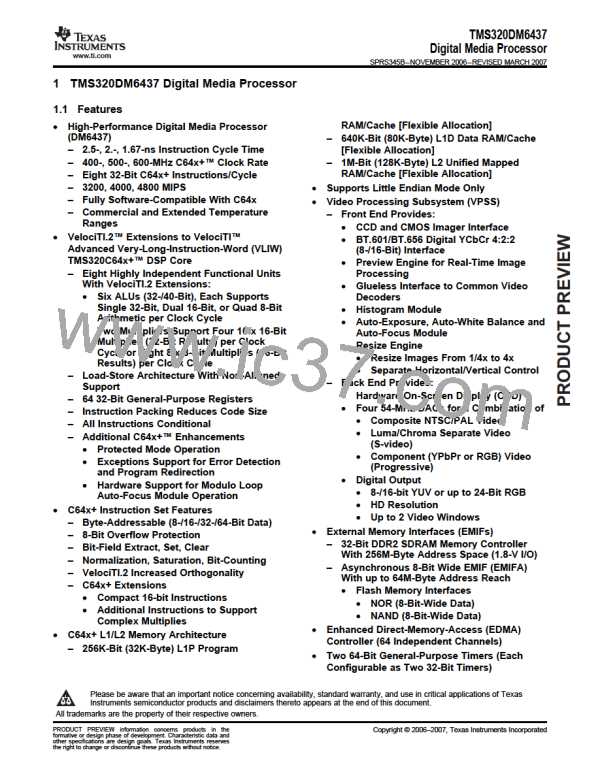TMS320DM6437
Digital Media Processor
www.ti.com
SPRS345B–NOVEMBER 2006–REVISED MARCH 2007
Table 6-57. Switching Characteristics for Host-Port Interface Cycles(1)(2)(3)
(see Figure 6-32 through Figure 6-35)
-400
-500
-600
NO.
PARAMETER
UNIT
MIN
MAX
For HPI Write, HRDY can go high (not
ready) for these HPI Write conditions;
otherwise, HRDY stays low (ready):
Case 1: Back-to-back HPIA writes (can
be either first or second half-word)
Case 2: HPIA write following a
PREFETCH command (can be either
first or second half-word)
Case 3: HPID write when FIFO is full
or flushing (can be either first or
second half-word)
Case 4: HPIA write and Write FIFO not
empty
For HPI Read, HRDY can go high (not
ready) for these HPI Read conditions:
Case 1: HPID read (with
Delay time, HSTROBE low to
HRDY valid
5
td(HSTBL-HRDYV)
12
ns
auto-increment) and data not in Read
FIFO (can only happen to first
half-word of HPID access)
Case 2: First half-word access of HPID
Read without auto-increment
For HPI Read, HRDY stays low (ready)
for these HPI Read conditions:
Case 1: HPID read with auto-increment
and data is already in Read FIFO
(applies to either half-word of HPID
access)
Case 2: HPID read without
auto-increment and data is already in
Read FIFO (always applies to second
half-word of HPID access)
Case 3: HPIC or HPIA read (applies to
either half-word access)
6
7
ten(HSTBL-HD)
td(HRDYL-HDV)
toh(HSTBH-HDV)
tdis(HSTBH-HDV)
Enable time, HD driven from HSTROBE low
Delay time, HRDY low to HD valid
2
ns
ns
ns
ns
0
8
Output hold time, HD valid after HSTROBE high
Disable time, HD high-impedance from HSTROBE high
1.5
14
12
For HPI Read. Applies to conditions
where data is already residing in
HPID/FIFO:
Case 1: HPIC or HPIA read
Case 2: First half-word of HPID read
with auto-increment and data is
already in Read FIFO
Delay time, HSTROBE low to
HD valid
15
td(HSTBL-HDV)
15
ns
Case 3: Second half-word of HPID
read with or without auto-increment
For HPI Write, HRDY can go high (not
ready) for these HPI Write conditions;
otherwise, HRDY stays low (ready):
Case 1: HPID write when Write FIFO is
Delay time, HSTROBE high to full (can happen to either half-word)
18
td(HSTBH-HRDYV)
12
ns
HRDY valid
Case 2: HPIA write (can happen to
either half-word)
Case 3: HPID write without
auto-increment (only happens to
second half-word)
(1) M = SYSCLK3 period = (CPU clock frequency)/6 in ns. For example, when running parts at 600 MHz, use M = 10 ns. TBD
(2) HSTROBE refers to the following logical operation on HCS, HDS1, and HDS2: [NOT(HDS1 XOR HDS2)] OR HCS.
(3) By design, whenever HCS is driven inactive (high), HPI will drive HRDY active (low).
246
Peripheral Information and Electrical Specifications
Submit Documentation Feedback

 TI [ TEXAS INSTRUMENTS ]
TI [ TEXAS INSTRUMENTS ]